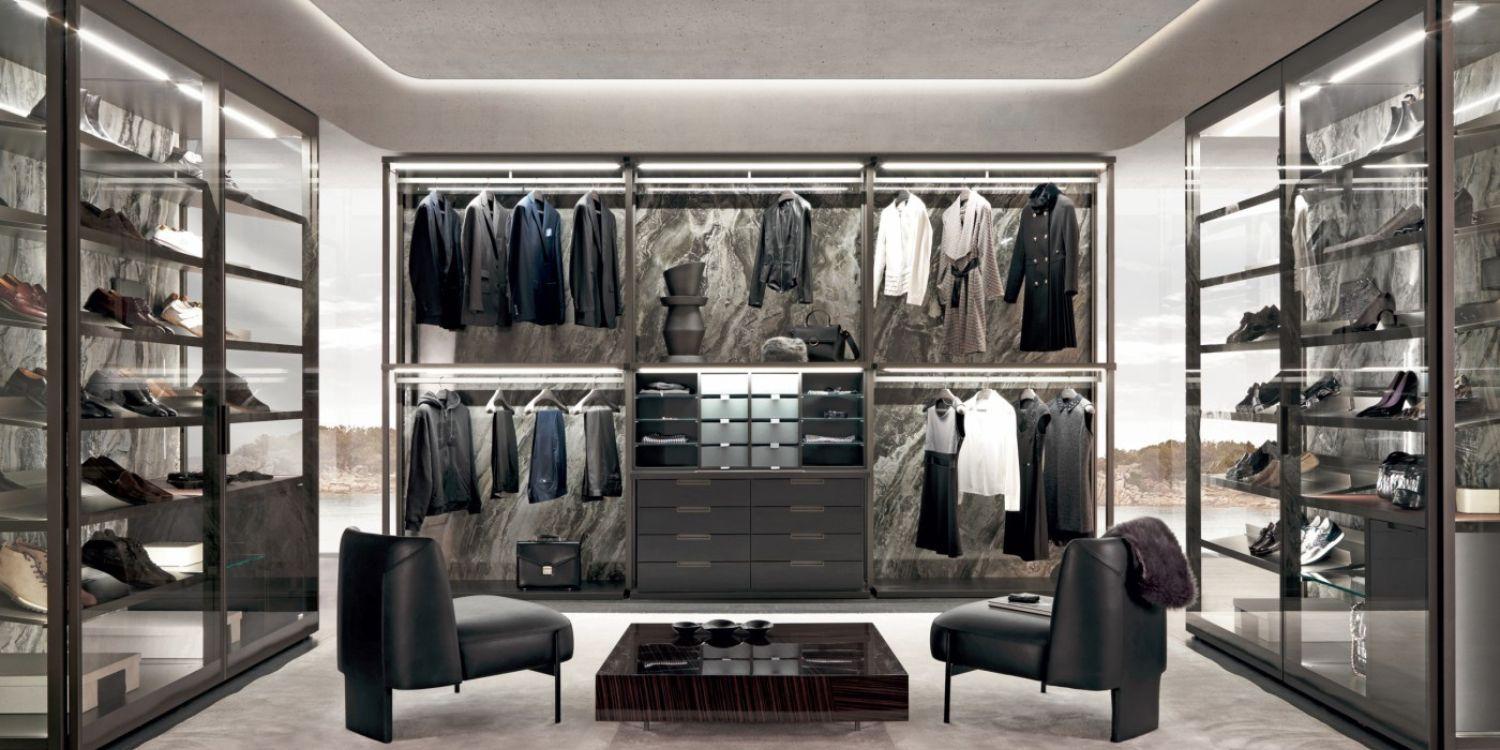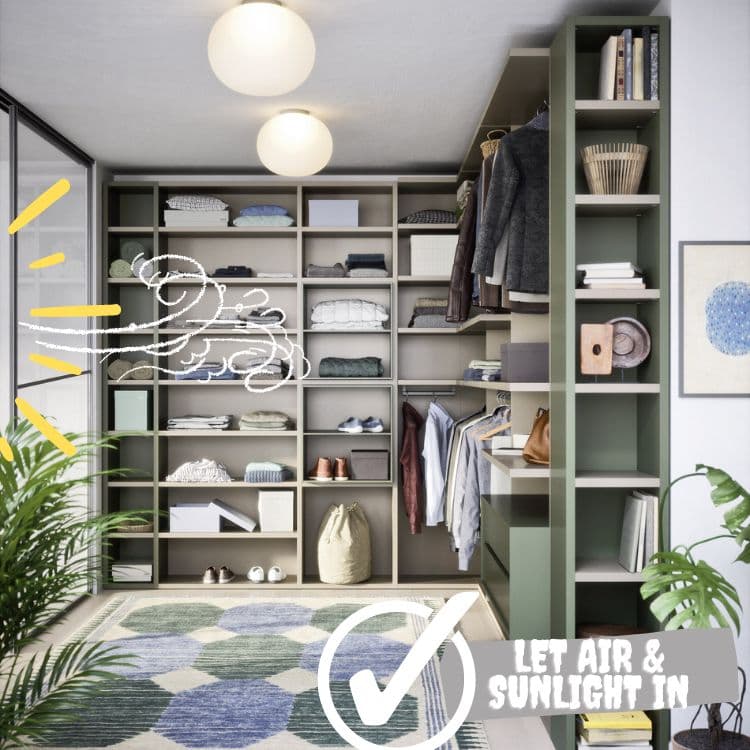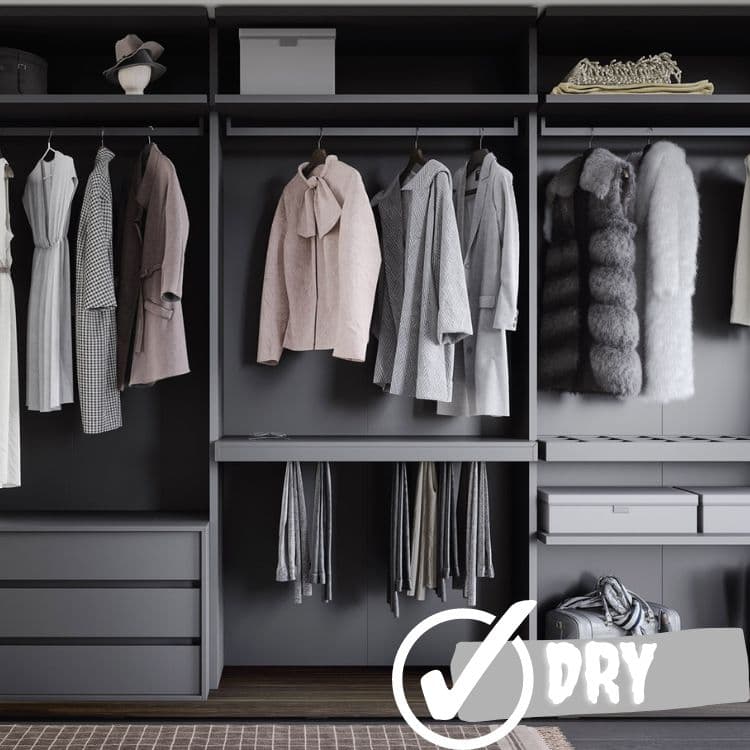If you’re asking yourself, “What can I put in my Wardrobe to stop damp?” then it’s probably too late to take any preventative measures. And, in answer, viable solutions will depend on how severe the problem is.
In cases where a mould infestation has started eating into the structure of your cabinetry, saving it may not be possible. In such scenarios, investing in a complete wardrobe refurbishment might be the best solution.
However, if you’ve caught it in the early stages, then there are things you can do to mitigate the effects.
Join our experts as we take a look at what causes dampness, its side effects and how you can stop it. We’ll also give you some organisational tips that will minimise the chances of it happening in the first place.

What triggers damp in a wardrobe?
Recognising the sources of dampness will help you to take appropriate action before the problem even manifests. So, if you’re about to build a fitted wardrobe or have just done so, these are the things to look out for:
- Bad installation: If your wardrobe is attached directly to your wall (leaving no breathing space) and there are any signs of moisture, then you’re in for an impossible battle. Should you decide to go this route, make sure that there is adequate insulation first. Or contact our expert design team for some good advice.
- Closeness to plumbing: Cabinetry that’s too close to any water lines runs the risk of succumbing to leaks, so check your floor plans before you decide on where you’re going to build it.
- Poor ventilation: Air circulation is fundamental to a healthy wardrobe, so if that’s not taken care of, dampness is sure to ensue.
- Condensation: Close proximity to an ensuite bathroom (yes, we all love a bit of steam), will cause condensation. This is likely to creep into your wardrobe, especially if you keep your windows closed.
- Humidity: If you live in a coastal town or in areas that have high humidity levels, you may find damp buildup more prolific.
- Overstuffing: Shovelling clothing into every possible space in your cupboard will prevent sufficient airflow and encourage moisture to linger.
- Damp clothes: Many people put their garments away without drying them properly first. This is a surefire way to guarantee a whole range of issues.
- Lack of moisture absorption: Without appropriate prevention devices, any wardrobe is susceptible to a buildup of damp. So, if you’re in the process of a bedroom refurbishment project, we suggest you go the professional route and get the job done properly.
At FCI London, we build free-standing units that are customised according to your space and are then installed to fit. This means that, if your walls develop a damp issue at any point, your cabinetry will not be affected by it.
If you’re still concerned about the issue, we also offer the option of including UV lights, preventing bacteria from developing even in damp conditions.
The consequences of dampness in cabinetry
While you may not think it’s serious at the time, an accumulation of dampness in your wardrobes can have some pretty drastic side effects. Let’s discuss them:
- Fungal growth: An abundance of moisture fosters the spread of mould and mildew, which is harmful on many levels. From destroying your clothes, shoes and accessories to putting your health at risk, any signs of them should be dealt with immediately.
- Bad smells: Dampness causes a musty odour that is not only hard to live with but can infiltrate your clothing, making it unpleasant to wear.
- Fabric damage: Even without the onset of mould, constant moisture will alter the integrity of your garments, weakening the fibres and enhancing wear and tear.
- Pests: Moist environments attract insects like silverfish, which can eat through textiles and clothing.
For these reasons, regular care, including the management of any moisture, is imperative to protecting your possessions, wardrobe structure and general well-being.
What will help manage dampness in a wardrobe?
Whether you’ve installed a generous corner unit like Logo’s Design #30 or opted for something simple like the Pleione walk-in by Barel, dampness is a no-no. Here are some things that will help to keep them dry:
- Silica gel pouches: Widely used in all closed storage units, this useful substance helps to absorb moisture and stop fungal growth.
- Charcoal air-purifying bags: Charcoal briquettes packed in breathable fabric bags are easy to find and reduce damp, odour and other toxins. Remember to expose them to sunlight at least once a month to help rejuvenate their efficacy.
- Shelf liners: Whether you choose old-school paper rolls or reusable washable plastic liners, these are an excellent way to keep moisture at bay.
- Table fans: Place a small fan inside your wardrobe every day if possible to enhance airflow and bring freshness to your belongings.
How to stop damp from forming in a wardrobe?
If you’ve detected a damp issue, we suggest you take the following measures to ensure that it doesn’t occur again:
- Keep the doors open: Do this as often as you can. If that’s not possible, you might want to consider changing your design to an open-concept format like the Atlante offering by EmmeBi. It’s also important to keep your windows open regularly to allow fresh air and sunlight into your bedroom.
- Buy a decent dehumidifier: You can find them in almost any size these days, including portable ones, so invest in a high-quality unit to get rid of dampness in your wardrobe for good.
- Completely dry your items before storing: If you hang damp clothes or place sodden shoes in closed cabinetry, the spread of moisture is almost guaranteed. So make sure it’s something you never do.
- Don’t overpack it: If you want everything to stay fresh and damp-free, it is important to create airflow inside your shelving, drawers and hanging space. So don’t overstuff them. Those with huge clothing collections should store seasonal items away in vacuum bags until they’re ready to be used again.
- Declutter twice a year: Whatever the reason, we’re all guilty of hoarding things we don’t want. So make it a habit to go through your shoes, garments and accessories biannually and turf out items you no longer need. This will help keep the interior of your closet organised and clutter-free.
- Have a cleaning routine: Wardrobes, like any other luxury furniture item, should be properly maintained to keep dirt at bay. This will also discourage mould and mildew from growing and will get rid of any spores that may be floating around.
- Waterproof your surfaces: Ask your wardrobe design team about sprays that can be used to waterproof and seal cracks in your cabinetry.
Welcome to FCI London
We help designers & clients transform mundane spaces into extraordinary ones.


In Conclusion
Remember, dampness in wardrobes is a common problem in British households, so if you find it, the first step is not to panic. At the same time, it’s important to take quick action so that it doesn’t spread or cause any harm to you or your belongings.
If you’re just about to begin your custom cabinetry journey or need to replace an existing one, make a showroom booking with us today. With three decades of experience and over 200 different materials, colours and finishes to choose from, we can build you something that meets all of your expectations.
We are fanatical about luxury fitted wardrobe design.
Take a look at our range of contemporary wardrobes.
Talk to a wardrobe expert now or book an appointment.

Book A Video Chat
Book a Zoom consultation and we’ll advise you on furniture, space planning, wardrobes and more.
Book A Video Chat

Book A Showroom Visit
Let our experts guide you through our 30,000 sq. ft. showroom with over 700 luxury brands under 1 roof.
Book A Consultation

Whatsapp
Email, call or book a virtual video chat with our sales team. Ask questions with no obligations.
Chat Now
















